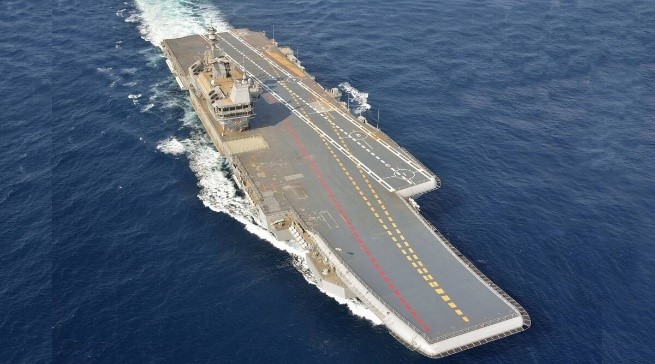Published on: September 2, 2022

India’s first indigenous aircraft carrier
India’s first indigenous aircraft carrier

Why in news?
Prime Minister Narendra Modi will commission the first indigenous aircraft carrier, INS Vikrant, at the Cochin Shipyard Limited in Kochi
Highlights:
- It will be the first indigenously designed and built aircraft carrier.
- Designed by the Indian Navy’s in-house Warship Design Bureau (WDB) and built by the Cochin Shipyard, a public sector shipyard.
- Vikrant has been built with state-of-the-art automation features and is the largest ship ever built in the maritime history of India.
- The aircraft carrier is named after her illustrious predecessor, India’s first, which had played a vital role in the 1971 wa
- It has a large number of indigenous equipment and machinery, involving major industrial houses in the country as well as over 100 MSMEs.
- With the commissioning of Vikrant, India will have two operational aircraft carriers, which will bolster the maritime security of the nation
- Commissioning of the country’s first aircraft carrier Vikrant will enhance peace, security and stability in the Indian Ocean and Indo-Pacific Region
- five sets of trials have been carried out since August 2021 and were extremely successful
- From the propulsion, equipment and weapons point of view, the ship is fully operational.
- INS Vikrant, with a displacement of 42,800 tonnes, is powered by four General Electric engines and can carry an air wing of 30 helicopters, fighters, and UAVs. The keel was laid in 2009 and was launched in water in 2013. “Using a novel aircraft-operation mode known as Short Take Off But Arrested Recovery (STOBAR), the IAC is equipped with a ski-jump for launching aircraft, and a set of three ‘arrester wires’ for their recovery onboard
the new naval ensign (Nishaan)
- PM Modi will also unveil the new naval ensign (Nishaan), doing away with the colonial past and befitting the rich Indian maritime heritage
What has changed?
- The Indian Navy has a white flag which has horizontal and vertical red stripes. This symbolizes the Cross of Saint George and the intersection is superimposed with the emblem of India. The Tri Colour is placed in the upper canton next to the staff.
Has the Naval Ensign been changed before?
- This will be the fourth time since 1950 that the ensign has been changed.
- Since 1950 the Naval Ensign has undergone changes three times. On 2nd September, it will be the fourth time.
More about the earlier changes
- When India became a republic on January 26, 1950, the Navy Crest and Flags were Indianised. The Ensign and Distinguishing Flags, however, retained a legacy of the British – while the Union Flag was replaced immediately by the Indian tricolour, the Red St. George’s Cross remained.
- Until 2001, the Indian Navy retained the Red Saint George’s Cross in its flags and ensigns, unlike other former colonial navies who had discarded the Cross in their flags and ensigns.
- It was on August 15, 2001, the Indian Navy’s design of the ensign was changed and it was then the Cross was removed from the Crest of the Indian Navy.
- The original ensign was adopted again by the Indian Navy in 2004
- Another round of changes took place in 2014, when the ensign and naval crest both were updated. Now they are inscribed with “Satyameva Jayate” which is in the Devanagari script.

